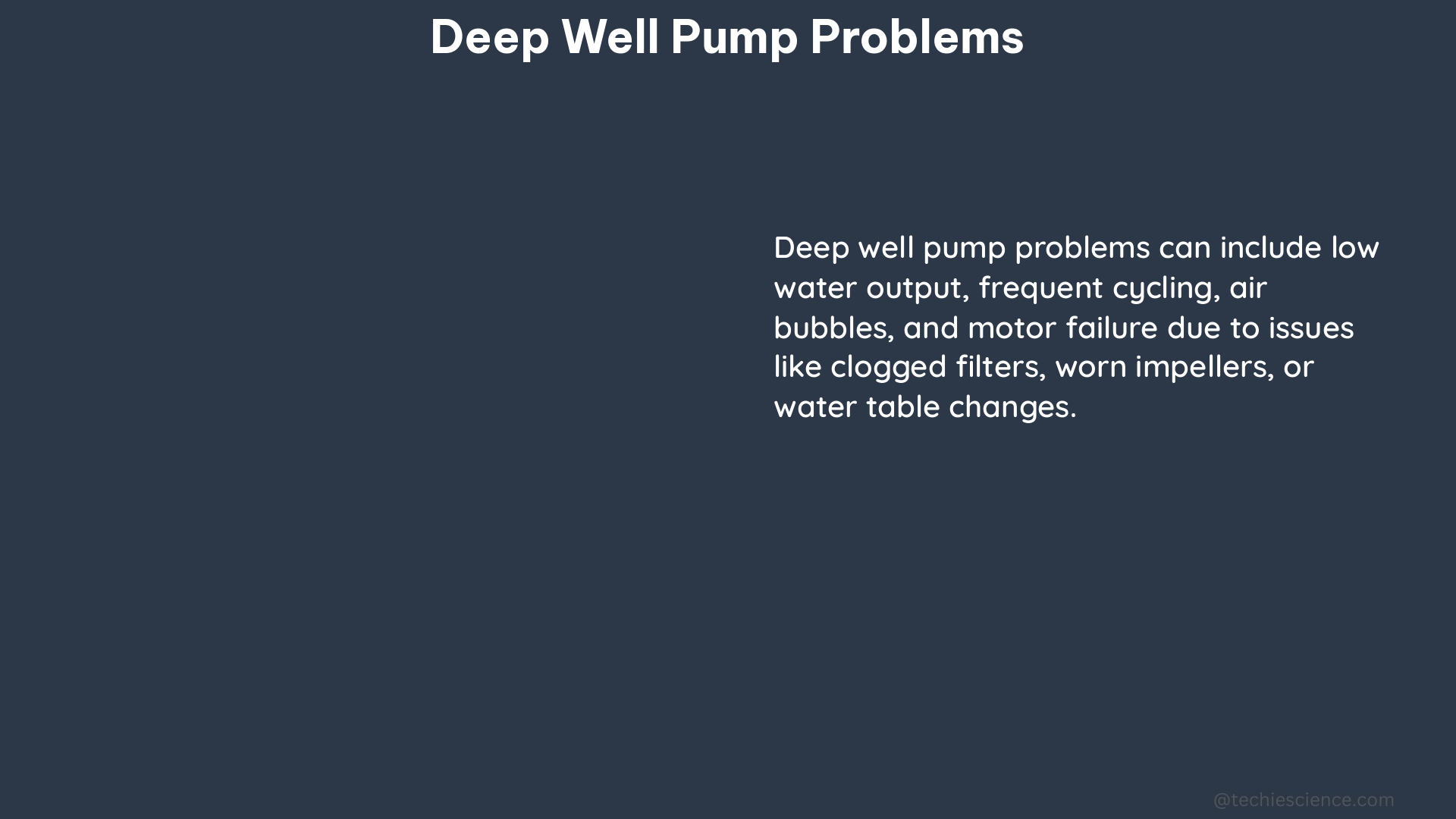Deep well pump problems can be a significant headache for homeowners, as they can lead to a disruption in water supply, increased energy costs, and potential damage to the well system. These issues can be caused by various factors, including faulty pressure switches, pressure tanks, well screens, or the pump itself. To help you navigate these challenges, this comprehensive guide will provide you with a detailed understanding of the common deep well pump problems, their causes, and the steps you can take to diagnose and fix them.
Identifying Deep Well Pump Problems
- Water Pressure Fluctuations
- Normal water pressure range: 40 to 60 psi
- Consistently low or high pressure could indicate a problem with the pump or well system components
-
Use a pressure gauge to measure the pressure at various points in the system
-
Pump Running Time
- Normal pump running time varies based on well size and water demand
- Excessive or constant running could suggest issues with the pressure switch or pressure tank
-
Monitor the pump’s runtime and compare it to the expected runtime for your well system
-
Sediment in Water Lines
- Presence of sediment or debris in the water lines could indicate a problem with the well screen or an oversized pump
- A faulty well screen can allow sediment to enter the pump and water supply
-
An oversized pump can draw in loose debris, damaging the pump and well system
-
Unusual Sounds from Pump
- Grinding, squealing, or banging noises from the pump could signify issues with the motor, impellers, or other components
-
These sounds can help identify the specific problem area within the pump
-
Changes in Water Quality
- Alterations in the taste, smell, or appearance of the water could indicate a problem with the well or pump
-
Water quality changes can be caused by bacterial growth, mineral encrustation, or other contaminants
-
High Electricity Bills
- Unusually high electricity bills may be a sign of a problem with the well pump
- An inefficient or excessively running pump can consume more electricity, leading to higher utility costs
Diagnosing and Fixing Deep Well Pump Problems

- Pressure Switch
- The pressure switch signals the pump to turn on and off based on the pressure in the well system
- Use a multimeter to test the continuity and resistance of the pressure switch
- Normal resistance range: 50 to 500 ohms
-
Replace the switch if it is faulty
-
Pressure Tank
- The pressure tank stores water under pressure and helps regulate the pressure in the well system
- Use a pressure gauge to measure the tank’s pressure
- Normal pressure range: 20 to 60 psi
-
Adjust the air charge or replace the tank if the pressure is too low or too high
-
Well Screen
- The well screen prevents debris and sediment from entering the pump
- Inspect the screen for damage or blockages by removing the pump
-
Clean or replace the screen if it is damaged or clogged
-
Pump Inspection and Maintenance
- Visually inspect the pump for any signs of wear, damage, or debris buildup
- Check the pump’s impellers, seals, and other components for proper functioning
-
Clean or replace the pump if necessary
-
Well Depth and Pump Sizing
- Ensure that the pump is properly sized for the depth and water demand of the well
- An oversized pump can draw in debris and cause premature wear
- Consult a professional to determine the appropriate pump size for your well
By following these steps and using the provided technical specifications and data points, you can effectively diagnose and address deep well pump problems. Remember to always prioritize safety and consider seeking professional assistance if you are unsure about any aspect of the repair process.
Reference:
- Troubleshooting a Deep Well Pump
- 5 Common Well Pump Problems and How to Fix Them
- Deep Well Jet Pump Will Not Build Pressure

The lambdageeks.com Core SME Team is a group of experienced subject matter experts from diverse scientific and technical fields including Physics, Chemistry, Technology,Electronics & Electrical Engineering, Automotive, Mechanical Engineering. Our team collaborates to create high-quality, well-researched articles on a wide range of science and technology topics for the lambdageeks.com website.
All Our Senior SME are having more than 7 Years of experience in the respective fields . They are either Working Industry Professionals or assocaited With different Universities. Refer Our Authors Page to get to know About our Core SMEs.